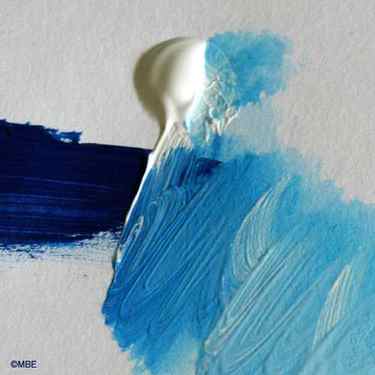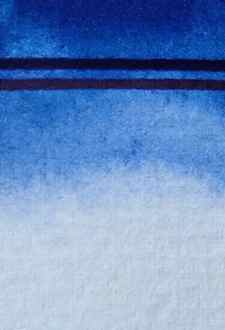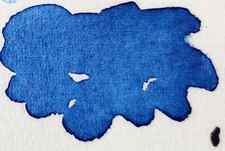Color index name is PB15:1 some manufacturers use PB15:6. It is common for the color to be given other names, which is confusing. The most common alternative names are: Berlin Blue (should actually be Iron Blue), Helio Blue and Monastral Blue. Some manufacturers simply call Phthalo blue after themselves: Winsor Blue, Blockx Blue.
Phthalo Blue (Green vs Red Shade)
Phthalocyanine is actually a chemical compound commonly used for dyes and pigments. One of the main characteristics is the high intensity of the colours. Phthalocyanine Blue or Phthalo Blue is a bright, crystalline, synthetic blue pigment from the group of phthalocyanine dyes. Daniel Smith offers two versions of Phthalo Blue, one’s a green shade and the other a red shade. The pigment used are PB 15:3 and PB 15:6 respectively. The one in my palette of Daniel Smith watercolours is Phthalo Blue (GS). Daniel Smith claims for PB Green Shade:
For cool, clean staining shadows and reflected light on windows. Super staining, super transparent Phthalo Blue is a popular pure chroma organic pigment. Mix with Hansa Yellow for luminous greens.
And for Red Shade:
A powerful blue with a slightly red undertone, this popular pigment is valued for its strength and economy—just a daub of paint can color a whole sky. A dash of blue gives a full range of value. Mix dark colors for shading and shadows by combining Phthalo Blue with Quinacridone Rose. Use Phthalo Blue’s transparent quality to create containers and water around stems.

Main attributes of Phthalo Blue are transparency, amazing tinting strength and staining power. You just need a tiny bit of pigment and it is often enough to get an intense wash, or shift the colour of mixtures. It’s also very staining so it’s very difficult to lift it off watercolour paper, or even off any surface. Have a drop on your clothes, wooden table or floor and you’ll find that it’s almost impossible to clean it off. Be careful!
I’ve always wondered about the differences between the green and red shade so recently I bought a tube of red shade to compare. Below’s the chart I painted out with other colours.
PB Green Shade is cooler compared to PB Red Shade. You can use both for skies so it really depends on your preference. PB Green Shade is what I would associate with a cheery sky blue that has a stylised look because blues in nature are not so bright and clean. PB Red Shade feels closer to actual colour of the sky. I find PB Red Shade closer to French Ultramarine because the latter is also a warm blue, but much warmer. I tried to mix a cool Lemon Yellow with Phthalo Blue hoping that I can get something close to Phthalo Green and you can sort of get close to it if you add more blue. However, I still prefer to have Phthalo Green instead of mixing to get it because yellow is a colour that’s quite easy to get dirty, and I use Phthalo Green a lot so it saves me a lot of time from having to mix it. From the colour chart above, I can see that the cooler secondary colour such as green is brighter when you get that mixture using PB Green Shade. As for purple, you can get a brighter version from using PB Red Shade. I love to use PB Green Shade with Transparent Pyrrole Orange because it gives me a nice cool gray. I can add lots of pigment and it will give me an intense dark that’s close to black. It seems that when mixed with PB Red Shade, the mixture is more brownish. There doesn’t seem to be any difference when the two PB are mixed with Burnt Sienna. You can get a neutral black if you mixed PB Green Shade, Lemon Yellow and Transparent Pyrrole Orange, but you have to get the proportion right. These three colours also give you lots of beautiful variations of grays. If you like more subdued greens, get PB Red Shade for the red will neutralise the greens. Personally for me, I like the Green Shade version better, especially when diluting it to colour the sky. You can find both Phthalo Blues on Amazon at
https://www.amazon.com/gp/product/B001PTCTYK?tag=artprdus-20
https://www.amazon.com/gp/product/B001PT8XA4?tag=artprdus-20
Paint Pigments: Phthalo Blue (PB 15)
A profile of phthalo blue paint pigment, including its characteristics.

- Fine Arts & Crafts
- Painting
- Drawing & Sketching
- Arts & Crafts
Marion Boddy-Evans is an artist living on the Isle of Skye, Scotland. She has written for art magazines blogs, edited how-to art titles, and co-authored travel books.
Updated on 01/11/18
Characteristics: Phthalo blue is a bright, intense blue that’s very dark when used thickly. Used as a thin glaze it’s very transparent. Mixed with white it’s an opaque, beautiful sky blue. Phthalo blue is available in green and red shades.
Common Names: Thalo blue, monestial blue, Winsor blue, monastral blue, phthalocyanine blue, heliogen blue, intense blue, Old Holland blue, Rembrandt blue.
Color Index Name: PB 15. PB15.6 (green shade). PB 16 (metal-free).
(Color Index Explained)Color Index Number: 74100. 74160.
Pigment Origin: Copper phthalocyanine, a synthetic organic pigment.
Used for Painting Since: 1930s. (Invented in 1928.)
Opacity/Transparency: Transparent.
Tinting Ability: Strong.
(Tinting explained)Lightfastness Rating: ASTM I.
(Lightfastness explained)Oil Paint Drying Speed: Slowish.
Specific Notes:
- Sometimes used as a cheaper alternative for cerulean blue.
Quotes About This Pigment:
“Prized for its mixing abilities, it [phthalo blue] has also become the basis of many student-range blues as it can be reduced considerably and still offer a strong color.” — Simon Jennings, Artist’s Color Manual, p14.
“As a blue pigment, [phthalo blue] shares none of the luxuriant hue of ultramarine; but its importance lies more in the fact that it absorbs red and yellow almost totally, while transmitting or reflecting blue and green.” — Philip Ball, Bright Earth, p279.An Alternative to Phthalo Blue?
Color Theory: Know Your Reds
Limited Color Palettes for Plein Air Painting
How to Read the Label on a Tube of Paint
How to Select Colors for Pastel Painting
Mixing Colors: What You Need to Know About Tints, Tones, and Shades
Sea Painting: Understanding What You’re Trying to Paint
Tertiary Colors and Color Mixing
How to Mix Greens
A Study in Painting or Fine Art
Symbols in Drawing and Painting
The Camera Obscura and Painting
What Is Gesso in Painting?
Signing a Copy of Someone Else’s Painting or Photo?
Painting Critique Checklist
How to Paint Like a Fauve- About Us
- Advertise
- Careers
- Privacy Policy
- Editorial Guidelines
- Contact
- Terms of Service
- EU Privacy
LiveAbout is part of the Dotdash Meredith publishing family.
When you visit the site, Dotdash Meredith and its partners may store or retrieve information on your browser, mostly in the form of cookies. Cookies collect information about your preferences and your devices and are used to make the site work as you expect it to, to understand how you interact with the site, and to show advertisements that are targeted to your interests. You can find out more about our use, change your default settings, and withdraw your consent at any time with effect for the future by visiting Cookies Settings, which can also be found in the footer of the site.
Characteristics
- Extremely strong color pigment.
- Phthalo blue is very transparent
- The paint is very staining. The pigment grains are extremely small, which means that it sticks to all surfaces. (eg plastic pallets), the paint is staining.
- Dries evenly and nicely, no granulation, perfect for smooth washes.
- The paint loses a lot of saturation when it dries.
- Excellent mixing properties.
- Complementary color: red-orange.
- Relatively cheap pigment, usually in the cheapest series from the manufacturers.









